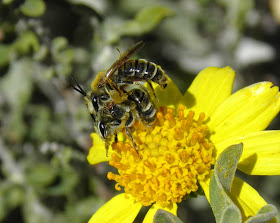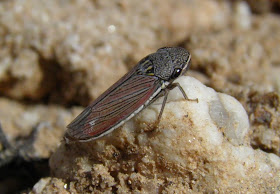Pages
▼
Monday, March 12, 2012
Brittle Bush Bee Heaven
Last year a late, very strong freeze kept many Brittle Bushes in the Tucson Mountains from blooming. In March it felt as if all kinds of interesting bees had found their way into our protected backyard habitat. Of course, the distances that these small endemic bees travel are really quite small. But for whatever reason, my BugGuide entries for last March show dozens more species than I'm finding this year.
So far I saw no Colletes (left), few Anthophora (middle) even though the Penstemons are already past their prime, and the long horned Eucera (right) are still missing. While a Leaf-cutter bee in Saguaro National Park volunteered to star in a video, I hardly see any in our backyard. The cactus bee Diadasia will certainly show up once the cacti are in flower.
Lasioglossum sisymbrii (left) is here, and several Agapostemon species (middle and right), some of them very pretty and shiny green. Some Agapostemons had been invading our living room windows throughout the winter to the delight of a resident Kukulcania Spider.
In the early morning hours, Honey Bees seem to be taking advantage of their greater body mass and thermoregulated hives: they visit the Brittle Bushes when it is still rather cool. (this observation is contrary to the info in BugGuide - Maybe the remarks there refer to climate conditions different from Arizona's)
Around noon, by far the dominant genus in our backyard is Adrena, recognizable by their furry faces (facial fovea). I'm seeing at least 2 morpho-species, a brown one and one with a partly rust-colored abdomen. The females collect pollen into tibial brushes similar to those of honey bees. They will take the pollen to their solitary ground nests. Each egg will be laid on its own ball of pollen and sealed in its own chamber. Our sandy, dry soil is just perfect for these Mining Bees.
Adrena males are smaller and more narrowly built, with the light face that is characteristic for many male bees. They spend their time hovering and zigzagging over the flowers. They rarely land to refuel with nectar. All bees that are quietly collecting attract their attention. Although pheromones prevent greater confusion, these eager males zoom in on anything from Agapostemon to Honey Bee. It's quite annoying if you are trying to photograph.
If they find a conspecific female they grab it, and in most cases a struggle ensues which usually makes both bees fall off the flower and out of focus. To get photos I finally just focused on an attractive female and waited for the males to show and that worked like a charm.
The abundance of Adrena females also drew another visitor with a quite different agenda. Today I found my first Nomada Bee and promptly misidentified it as a wasp. Nomadas got their name from the fact that they have no nest of their own. Instead, they are clepto-parasitic cuckoo bees, depositing their eggs into the nests of the other bees, mostly in the genus Adrena.
Tuesday, March 6, 2012
Of Pollen Pigs and Faithfull Bees in Saguaro National Park West
There are a few nice Poppy fields in Saguaro National Park West right off Picture Rocks Road, just where I cross the Tucson Mountains when I drive to the University. Randy and I consider this commute through the park a very good reason to live on a dirt road NW of Picture Rocks.
Otherwise poppies are scarce in SNMW, but the variety of wild flowers is great, from the earliest Fairy Dusters, Brittle Bushes and Lupines along the roads, Penstemons in sandy washes and many different members of the Mallow family, some of them spectacular fountains of orange, pink or white.
 |
| Desert Globemallow, Sphaeralcea ambigua |
All of them attract insects, either offering nectar and pollen to more or less specialized pollinators, or not so voluntarily (I assume) offering to nurture larvae and adults with everything from buds to leaves, petals, developing fruit and final seeds. Many insects are so specialized that they can only be found in certain years at the exact time when there are enough flowers of a certain species ...
Others are great generalists, like the ubiquitous honey bee. This, by the way, makes her a much less reliable pollinator than some of our native bees. Local entomologists call Apis mellifera the Pollen Pig: Abundant and able to shoulder the smaller native bees away from their food sources, ripping the base of deep-throated flowers to steal their nectar....they are the boars of the insect world.
 |
| Caliche Globemallow, Sphaeralcea laxa |
 |
| Adrena sphaeralceae visiting its Globemallow. Above female, lower right male |
Reaching for nectar at the bottom of the flower the bees curled their furry bodies around the center column that is formed by distinctive dark purple anthers and the pistil. Powdered richly with pollen in the process, they immediately visited another mallow flower. They never seemed to stray away from that particular species of mallows.
 |
| Adrena sphaeralceae |
Interestingly, there are other bee species from different genera tribes that are also specialized on Malvaceae, for example certain Melitoma and Diadesia species.
Although Darwin already described some of the extremest cases of interdependency between certain bee and orchid species, many questions about the evolution of oligolecty are still unanswered. While the benefit for the flowering plant seems obvious, cost and advantage for the bee are more difficult to analyze. It is not quite clear whether oligolecty is based on the inability of bee larvae to digest any but the preferred pollen, or if the adults are just not able to recognize other flowers as food sources. Speculations have been discounted that smaller species with a shorter flight radius are most likely to be oligoleges.
I was surprised to learn that about 30% of European and Asian bees are oligoleges. I couldn't find any data for the Americas, but they are probably similar.Definitely a topic to learn more about.
Sunday, March 4, 2012
Catalina State Park in March 2012
On March1, in Catalina State Park, we took the Southerland Trail to find beautiful golden fields of California Poppies. Randy and our dogs rested under the dramatic backdrop of Push Ridge and posed for every bodies photographs while I got my annual blister beetle shots and also found some nice new insects.
 |
| Lytta auriculata on Scorpionweed |
 |
| Lytta stygica on California Poppy |
 |
| The Giant Yucca Skipper in an aria with many Sotols that are among its host plants |
Cuerna arida, a little Sharpshooter related to cicadas
A pretty little moth that spends his whole life on the Desert Chicory plant: Heliolonche carolus
California Poppies, Eschscholzia californica, and Coulter's Lupine, Lupinus sparsiflorus
 |
| Creamcup Poppies, Platystemon, californicus |
 | |||
| Desert Anemone, Anemone tuberosa, and Owl Clover, Castilleja, exserta, formerly, Orthocarpus, purpurascens |
 |
| We all had a great day |
















